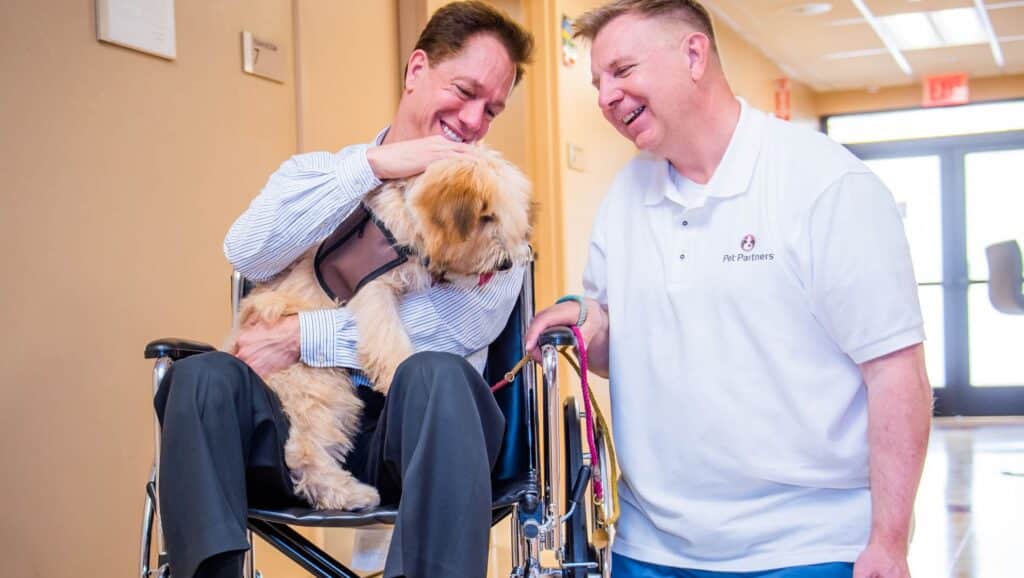



This interview was originally published July 15, 2019. There have been changes in some of the laws since this interview was originally published. We held a Facebook Live event with Ellie Wetzel on February 16, 2021 that covers some of this new information. You can view a recording of this event on our YouTube channel.
Registered therapy animals, like those who are part of Pet Partners therapy animal teams, have no legal definition or public access rights under federal law. However, as individuals who provide animal-assisted interventions (AAI), it’s important that we are educated in the laws regarding our field. Ellie Wetzel is a licensed attorney with a special interest in AAI law. She and her Great Pyrenees, Winnie, are also a registered team with Pet Partners. We talked with Ellie to help understand the laws surrounding emotional support animals and assistance animals, as well as the growing issue of fraud in this area.
Before delving into our interview, it’s important to understand the Americans with Disabilities Act (ADA). This act governs all public places and all transit with the exception of flight. A lot of the misunderstandings regarding services animals and emotional support animals occurs because different language is used by different federal agencies. The Service Animal Definition Matrix—Air Carrier Access Act vs. Americans with Disabilities Act breaks down how different agencies define “service animal” and “emotional support animal.”
When my husband Kevin and I adopted Winnie as a puppy in 2013, I was looking for activities to keep her stimulated as well as something fun for us to do together. Even as a puppy, she showed great interest in people, especially kids. I called the Children’s Hospital at Vanderbilt (Monroe Carell Jr. Children’s Hospital) to ask how we could become a volunteer team since I had heard about their therapy dog volunteers. They referred me to Pet Partners.
Once we became a Pet Partners team and began volunteering, we would get lots of questions from parents of kids with special needs about how they could get a service dog for their child. And often people were confused they were encouraged to pet Winnie since they assumed she’s a service dog. I would explain how she is a therapy dog and give a brief overview of the differences between therapy animals, service/assistance animals, and emotional support animals (ESAs).
Since there is a lot of confusion about the different categories, I proposed authoring an article for the Nashville Bar Journal to explain the differences and help educate the local legal community. While I was researching, I discovered this area of law is far more complicated than I anticipated. Much of the information online—even articles published by organizations that seem reputable—is inaccurate. Often, in trying to simplify the laws, the publications make misstatements. I became fascinated by the complexities of animal accommodation law and began digging into the regulations and the legal history. This has led me to author articles and documents to help clarify the issues and assist people in preventing assistance animal fraud.
Unfortunately, there is little law prohibiting the practice of these document mills. Part of that is due to the ADA intentionally being written broadly and essentially operating on an “honor system” so individuals with qualified disabilities are able to access needed animal assistance. ESAs require documentation from a mental health professional, whereas there is no law requiring registration or certification for service/assistance animals.
With the rise of telemedicine, mental health professionals are offering their services online. In the context of therapy animals, an online “consultation” is conducted (in some instances being very brief and entailing written responses to questions in lieu of speaking with, or interacting through videoconferencing with, a mental health professional). Then the professional makes their diagnosis in accordance with the Diagnostic and Statistical Manual of Mental Disorders (DSM) and provides the letter [prescribing an emotional support animal]. Thus, the person who has received the paperwork satisfies the legal requirement and is not violating the law.
The breakdown in the process, therefore, occurs with the prescriber and whether that mental health professional has fulfilled his or her professional oath and made an appropriate determination to prescribe a pet. While lay people and citizens can help prevent service animal fraud and ESA fraud, in a way, the responsibility is on practitioners of the mental health profession to report any of their colleagues who are not adhering to appropriate professional standards.
Additionally, the public needs education about the roles of therapy, service/assistance, and emotional support animals and the basic regulations that apply to each. For example, only service/assistance animals have right of access and federal law allows entities to ask certain questions before access is granted. Federal laws also provide bases for removing service animals that don’t comply with behavioral standards.
In my opinion, stricter federal laws are not the answer. The ADA was written intentionally as an “honor system” in order to ensure people with disabilities do not have to go through unnecessary burdens. The Department of Justice (DOJ) indicates such in their regulations. On the issue of a national registry, I think it is important to note that there is no such registry for other types of working animals—for example, there is no national registry for cadaver or HRD (human remains detection) dogs, so it is doubtful that one will exist for service animals any time soon.
Confusion already exists about animal registries in general; most people do not realize service/assistance animals as defined under the ADA have no registry requirement—all service dog registries are essentially frauds making money off people’s ignorance, and that is unfortunate. There is also the issue of who would oversee this registry. Right now, the registries you see online are operated as private businesses that make money off the registrations.
An alternative to a national registry is to criminalize assistance animal fraud; however, these types of laws are more appropriately enforced at the state level instead of the federal level.
We have to realize that this is still a somewhat new phenomenon. We also need to realize that the law governing assistance animals is relatively young. When the ADA was enacted, it had no definition of “service animals.” (The term “service animal” was coined in 1989 when American canine researcher Bonnie Bergin testified before Congress for the ADA, and at that time, the majority of service animals served in the role of guide dogs for the visually impaired.) The DOJ did not define the term “service animal” for purposes of the ADA until 1991 and revised the definition in 2010. Over the past few decades, the role of service/assistance animals has expanded with dogs being trained to help humans in a variety of capacities: mobility assistance, alerting and responding to seizures or blood sugar changes, assisting in grounding someone with PTSD in time and place, and more. This field is constantly evolving.
Laws concerning ESAs began in the early 2000s, for example the DOT regulations for ESAs on airplanes issued in 2003. The Department of Justice (which oversees regulations for ADA) and Department of Housing and Urban Development (which oversees regulations for housing) fleshed out the federal laws related to ESAs in their 2004 Joint Statement. And, to date, there are no federal laws regulating therapy animals.
Pet Partners, the nation’s leading therapy animal organization, began in the late 1970s. In the grand scheme of things, 40 years ago isn’t that long ago. Knowledge of therapy animals and the interest in facilities wanting therapy animal visitors has surged dramatically in the last decade.
Given the relative “newness” of this issue, it is understandable for there to be confusion. That is just a reality we have to confront. What is needed is better education about the various categories of animals, the basic laws that apply to each, and what questions you are entitled to ask under law to ensure a service dog or service mini horse are legitimate.
First, be kind. Many people have “invisible” disabilities, and while it might seem by looking at them they do not need a service dog, there are so many different types of service/assistance dogs. My first recommendation for anyone is to resist the snap judgement of assuming an animal is a fraud.
Additionally, many people with ESAs do not understand the laws governing ESAs. Someone with a legitimate need for an ESA might have used an online provider to get his or her letter because that was the only way they knew how to do so, or there was not a mental health provider available near them.
One of the most important things I think to keep in mind is to recognize fraud occurs knowingly and unknowingly, that is, intentionally and unintentionally. The person with a legitimate ESA letter might not realize their ESA does not have public access rights because the practitioner who “prescribed” the pet (i.e., authored their ESA letter) might not have explained the law clearly. People read about ESAs on planes and might assume it is okay to bring an ESA everywhere. In reality, ESAs can only be a reasonable accommodation for housing and they can fly on planes. Otherwise, they have no legal right to be anywhere else—some businesses may allow them, but they are not required to do so under the ADA.
The key is to help educate people about the different categories of animals, which is confusing given that different entities use different terms although the federal law is consistent in its definitions (with the exception of flight, but that is being revised now). It is also good to understand appropriate animal behavior in public—there are limitations on behavior even for service animals.
It is also good to know what questions may be asked to prevent assistance animal fraud. I give a quick overview in one of my articles. But really, many of the regulations are accessible and user friendly. People shouldn’t feel like they have to rely on a third party’s interpretation of the law and should be encouraged to review the law itself. The DOJ 2010 regulations are a great resource.* In the appendices, the DOJ goes over the comments it received when revamping its regulations and explains in detail why specific changes were made.
*The Appendix to 28 CFR Part 35 and the Appendix to 28 CFR Part 36, which are available at www.gpo.gov, provide detailed section-by-section analysis of the regulations and the rationale for the DOJ’s decisions (the portions concerning animals are located at 28 CFR pt. 35, App. A, at 551-552, 555-556, 583-590, 592-596, and 28 CFR p. 36, App. A, at 692-742). The section-by-section analysis for title II and title III also can be accessed at www.ada.gov. Since title III applies to public places, the analysis for the title III regulations is a great place to start. Information related to assistance animals in public places (title III) can be found on pages 5, 6-7, 33, 38-39, and 80-96.
As with most things, the key comes down to education rather than excessive regulation. Those involved as volunteers with their pets as therapy animal teams have a prime opportunity to help educate the public during their service.

Eleanor (Ellie) Wetzel has been a licensed attorney since 2000, and she is admitted to practice law in Indiana and Tennessee. She is an advocate of lifelong learning and thus far has devoted her career to legal research and writing, serving as a judicial clerk/staff attorney for state and federal courts: the U.S. District Court for the S.D. Indiana and, currently, Nashville Metropolitan/Davidson County Criminal Court.
Ellie is a registered therapy dog handler through Pet Partners. She and her dog Winnie are registered with Pet Partners and volunteer at the Children’s Hospital at Vanderbilt, the Davidson County Juvenile Court Foster Care Review Board, and special events. Ellie serves on the board of directors for the Pet Partners Community Partner Music City Pet Partners.
This article has been reviewed by Ellie Wetzel.